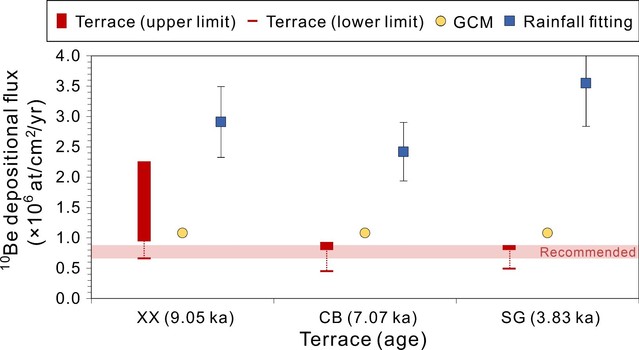Kai Dengab, Hella Wittmanna, Meng-Long Hsiehc, Shouye Yangb, Friedhelm von Blanckenburg ad
a GFZ German Research Centre for Geosciences, Earth Surface Geochemistry, Telegrafenberg, 14473, Potsdam, Germany
b State Key Laboratory of Marine Geology, Tongji University, Shanghai, 200092, China
c Department of Earth and Environmental Sciences, National Chung Cheng University, Chiayi, Taiwan
d Institute of Geological Sciences, Freie Universität Berlin, 12249, Berlin, Germany
Abstract:
The cosmogenic meteoric 10Be that is produced in the atmosphere and mainly scavenged by rainfall is a valuable tool for determining dates and rates of Earth surface processes. A key prerequisite for its applications is the knowledge of the long-term 10Be depositional flux to Earth's surface. Previous efforts on obtaining 10Be depositional fluxes include general atmospheric circulation modelling (GCM), empirical fitting of rainfall 10Be records, and determining the inventory of soil profiles of known age. Here, we derive 10Be depositional fluxes from Holocene river terrace 10Be inventories across the Taiwan mountain belt. We measured 10Be and 9Be concentrations from three terrace profiles, with 14C ages ranging between 3.83 and 9.05 cal. kyr BP and sampling depths of up to 6.2 m.
Based on 10Be inventories of our river terraces, the calculated long-term 10Be depositional fluxes vary from 0.32 to 0.49 × 106 at/cm2/yr in the Taiwan orogen. We identify partial Be retention, surface erosion, multi-phase sediment deposition, and incomplete sampling depth in these terraces as potential causes of flux underestimation. When accounting for each of these factors and their uncertainties, the resulting flux estimates of each terrace show an overlapping range of 0.66–0.88 × 106 at/cm2/yr. This newly constrained flux range representative over millennial timescales is thus recommended for Earth surface applications in the fast-eroding Taiwan orogen, especially in regions with similar climatic conditions as the studied terraces. When comparing to flux estimates from other approaches, the flux from the rainfall-based fitting equation exceeds our new terrace-derived flux by more than a factor of two. We consider such high flux to be unlikely for the Taiwan orogen, and suggest that the control of precipitation on the 10Be flux here may be overestimated in rainfall data fitting. The GCM-derived flux overestimates the 10Be depositional flux in this setting to a smaller degree (at least 23%), which is in accordance with findings from previous global data compilation of 10Be fluxes.
Full Article:https://doi.org/10.1016/j.quascirev.2021.107048


